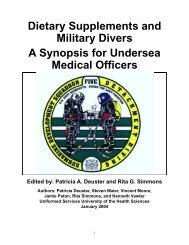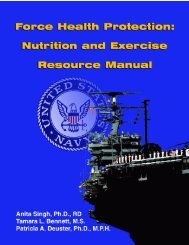Traumatic Brain Injury and Effects of Altitude - Human Performance ...
Traumatic Brain Injury and Effects of Altitude - Human Performance ...
Traumatic Brain Injury and Effects of Altitude - Human Performance ...
You also want an ePaper? Increase the reach of your titles
YUMPU automatically turns print PDFs into web optimized ePapers that Google loves.
<strong>Traumatic</strong> <strong>Brain</strong> <strong>Injury</strong> (TBI) <strong>and</strong> <strong>Effects</strong> <strong>of</strong> <strong>Altitude</strong>:An Analysis <strong>of</strong> the Literature17. Busto, R, Dietrich, W, Globus, M-T, et al. (1987). Small differences in intraischemic braintemperature critically determine the extent <strong>of</strong> ischemic neuronal injury. J Cereb Blood FlowMetab, 7, 729-738.18. Busto, R, Globus, M-T, & Dietrich, W (1989). Effect <strong>of</strong> mild hypothermia in ischaemia-inducedrelease <strong>of</strong> neurotransmitters <strong>and</strong> free fatty acids in rat brain. Stroke, 22, 37-43.19. Byrnes, KR & Faden, AI (2007). Role <strong>of</strong> cell cycle proteins in CNS injury. Neurochemical Research,32, 1799-1807.20. Cable, GG (2003). In-flight hypoxia incidents in military aircraft: causes <strong>and</strong> implications fortraining. Aviat Space Environ med, 74, 169-172.21. Cairns, CJ & Andrews, PJ (2002). Management <strong>of</strong> hyperthermia in traumatic brain injury. Curr OpinCrit Care, 8, 106-110.22. Carrel, M, Moeschler, O, Ravussin, P, et al. (1994). Prehospital air ambulance <strong>and</strong> systemicsecondary cerebral damage in severe craniocerebral injuries. Ann Fr Anesth Reanim, 13, 326-335.23. Cassidy, J.D., Carroll, L.J., Peloso, P.M., et al. (2004). Incidence, risk factors <strong>and</strong> prevention <strong>of</strong> mildtraumatic brain injury: results <strong>of</strong> the WHO Collaborating Centre Task Force on Mild <strong>Traumatic</strong><strong>Brain</strong> <strong>Injury</strong>. Journal <strong>of</strong> Rehabilitation Medicine, 36, 28-60.24. Centers for Disease Control <strong>and</strong> Prevention (2006). <strong>Traumatic</strong> <strong>Brain</strong> <strong>Injury</strong> in the United States:Emergency Department Visits, Hospitalizations, <strong>and</strong> Deaths. Prepared by Division <strong>of</strong> <strong>Injury</strong>Response, National Center for <strong>Injury</strong> Prevention <strong>and</strong> Control, Centers for Disease Control <strong>and</strong>Prevention, U.S. Department <strong>of</strong> Health <strong>and</strong> <strong>Human</strong> Services. January 2006.25. Cernak, I & Noble-Haeusslein, LJ (2010). <strong>Traumatic</strong> brain injury: an overview <strong>of</strong> pathobiology withemphasis on military populations. Journal <strong>of</strong> Cerebral Blood Flow & Metabolism, 30, 255-266.26. Chan, KH, Miller, JD, & Dearden, NM (1992). Intracranial blood flow velocity after head injury:relationship to severity <strong>of</strong> injury, time, neurological status <strong>and</strong> outcome. J Neurol Neurosurgpsychiatry, 55, 787-791.27. Chang, JJJ, Youn, TS, Benson, D et al. (2009). Physiologic <strong>and</strong> functional outcome correlates <strong>of</strong>brain tissue hypoxia in traumatic brain injury. Crit Care Med, 37, 283-290.28. Chestnut, RM, Marshall, LF, Klauber MR, et al. (1993). The role <strong>of</strong> secondary brain injury indetermining outcome from severe head injury. J Trauma, 34, 216-222.29. Chi, JH, Knudson, MM, Vassar, MJ, et al. (2006). Prehospital hypoxia affects outcome in patientswith traumatic brain injury: a prospective multicenter study. J Trauma, 61, 1134-1141.30. Clark, CF, Heaton, RK, & Wiens, AN (1983). Neuropsychological functioning after prolonged highaltitude exposure in mountaineering. Aviat Space Environ Med, 54, 202-207.31. Clarke, C (2006). Acute mountain sickness: medical problems associated with acute <strong>and</strong> subacuteexposure to hypobarix hypoxia. Postgrad Med J, 82, 748-753.32. Clifton, GL, Choi, SC, Miller, ER, et al. (2001). Intercenter variance in clinical trials <strong>of</strong> head trauma:experience <strong>of</strong> the National Acute <strong>Brain</strong> <strong>Injury</strong> Study: Hypothermia. J Neurosurg, 95, 733-755.33. Clifton, GL, Miller, ER, Choi, SC, & Levin, HS (2002). Fluid thresholds <strong>and</strong> outcome from severebrain injury. Crit Care Med, 30, 739-745.September 14, 2010 29


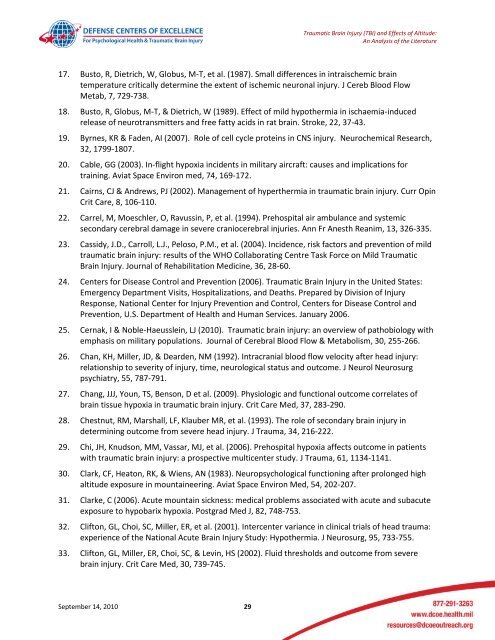
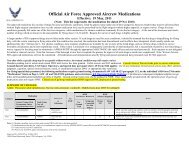
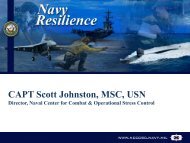
![Body Composition and Military [PDF] - Human Performance ...](https://img.yumpu.com/43269347/1/190x245/body-composition-and-military-pdf-human-performance-.jpg?quality=85)
![Tips for Grocery Shopping [PDF]](https://img.yumpu.com/37447379/1/190x245/tips-for-grocery-shopping-pdf.jpg?quality=85)
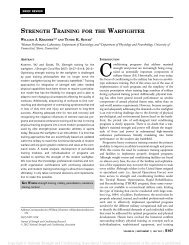
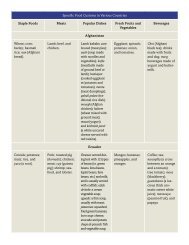
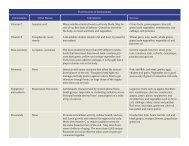
![Synthetic Drugs [PDF] - Human Performance Resource Center](https://img.yumpu.com/37447322/1/190x245/synthetic-drugs-pdf-human-performance-resource-center.jpg?quality=85)
